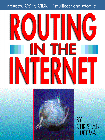
Routing in the Internet
This book seeks to address one very specific topic: the organization of routing, the structure that glues together the worldwide Internet. It is composed of an introduction, a conclusion, and 4 main parts:
- The first part presents the general principles of the Internet architecture and the Internet Protocol (IP) itself. In the second edition, this part includes a presentation of IPv6, which has been designed as replacement for the current version, IPv4.
- The second part covers the routing within organizations' networks. We first present RIP, the old Internet routing protocol. It is also an introduction to routing protocols in general, detailing the easy-to-understand "distance vector" technology. We present then the Open Shortest Path First (OSPF) protocol, an example of the "link state" technology. This part is completed by discussing the other interior routing protocols in use in the Internet.
- The third part presents the interconnection between organizations and providers networks. We present first the historic "Exterior Gateway Protocol" (EGP), then the modern "Border Gateway Protocol" (BGP). We discuss the development of Inter-Domain Routing" and the general requirements of "policy-based routing."
- The fourth part of this book is devoted to advanced routing technologies, such the support of multicast transmission, mobile hosts, and real-time applications.
Both editions are published by Prentice Hall. Click here for the book's reference page on the Prentice hall web site.